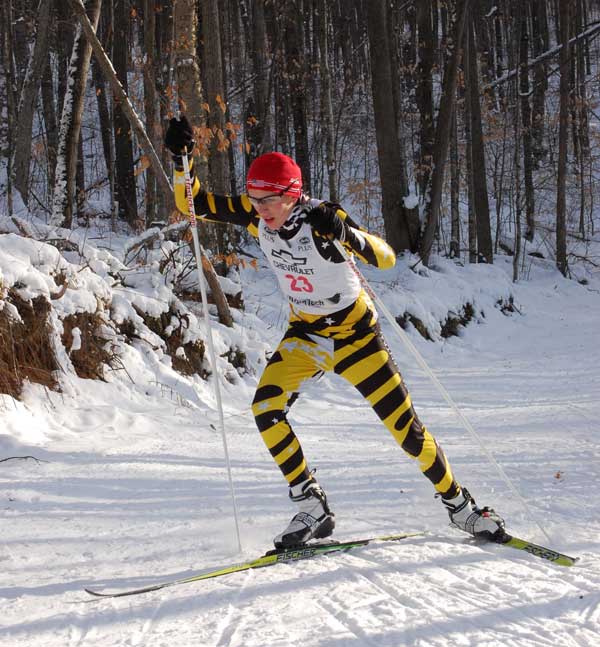
Tour de Ski: Liebner, Liebner, Liebner, and Liebner
Michigan Cup: Tour de Ski
Tue, Jan 1, 2013 - By Mike Muha
The Tour de Ski (the Michigan version) takes after it's big brother, the World Cup version of the Tour de Ski, with multiple events over multiple days. The race, held entirely on the trails of the Boyne Valley Lodge in Walloon Lake, MI, featured three races:
- A freestyle sprint race
- A freestyle hill climb
- A 10k classic race
To get Michigan Cup points (our equivalent to World Cup points), the racer had to complete all three events. Both Juniors and Seniors received points.
Freestyle Sprint
The day started at 9:00am with a sprint qualifying round. Each skier started in 15 second intervals and raced a two-lap time trial around the 400 meter course. The times were used to seed skiers for the sprint final: skiers were divided into groups of 6 based on time: the fastest six in one group, the next six fastest in the second group, and so on. Each group raced head-to-head for a final sprint standing starting at 10:30am. Men and women were mixed together in the heats - heat groups were determined by time, not gender.

Andy Liebner takes the inside powder-corner in the first lap of the sprint final. Ross Williams follows, then Andrew Bruning and Dan Yankus. (Photo by Peter Bruning)
Andy Liebner, author of Wild Shot: Struggles and successes in biathlon and cross country skiing, (now living in Cheboygan and racing for the Straits Striders), wore bib #1 and skied a fast 1:48 for the qualifying sprint. Others tried to beat it: Ross Williams skied a 1:54, and Andrew Bruning did a 1:57, but no one had a better time.
Junior Sarah Goble had the best female qualifier, timing in at 2:33.
In the sprint final Andy Liebner, Ross Williams, Andrew Bruning, Dan Yankus, Ryan Harris, Brendan Baic and John O'Hearn fought a mighty battle over the two-lap course. Liebner led the entire way, wining the overall sprint.
Sarah Goble won the sprint for the women, followed by Erica O'Hearn, and Erin Lipp.
Video of the A-final sprint (by Mike Muha)
Freestyle Hill Climb
The hill climb started at the Boyne Valley Lodge base, climbed a large hill to the right of the Stadium, came down and into the stadium, where skiers went around the perimeter until they started another long climb out of the stadium. The hill rose at a relatively easy to moderate incline, and featured a couple short downhills before climbing to the highest hill in the trail system. The course was around 2k. Skiers were started in order of sprint finish time, faster skiers first to minimize congestion on the trail.
Still wearing bib #1, Andy Liebner again led the way with a 3:47 climb. Ross Williams was second in 4:03, followed by Dan Yankus in 4:05.
At the end of day 1, Andy Liebner led the standings, winning both the sprint and the hill climb
Conditions were excellent, with good trail conditions and temperatures around 22F for the sprint and 26F for the hill climb. The skies were mostly cloudy.

Andrew Bruning, a junior, duking it out with the seniors for an overall second place in the cross country ski race series. Bruning was second behind Liebner in all events. (Photo by Peter Bruning)
6K/10K Classic Race
Saturday night brought a couple inches of fluffy lake effect snow. Temperatures were again in the low 20's on Sunday and the sky was cloudy. Waxing was...interesting. The tracks were firm, but step outside, and you were in new fluffy snow. If you waxed too warm, you iced as soon as you stepped in the fluff. Wax too cold, and you didn't have enough grip in the track. To add to the complication, the race was a two-lap (juniors) or three-lap (seniors) event, meaning that the tracks were likely to get harder and glazed during the race. Glazed tracks require softer kick wax.
One of the solutions was to wax on the warm side for the tracks, then cover the kick was with a colder wax for the fluffy snow. The softer wax underneath would provide a cushion that would allow grip in the tracks, and the harder top layer kept the ski from icing when in the new lake-effect snow.
The race featured a Gunderson Start, first used in Nordic Combined in the 1980s. How did this work? Skiers were give a total time for the previous day based on this formula:
Hill climb time
+ (2 x Sprint qualifier time)
- (:20/1st, :17/2nd, :15/3rd, :14/4th ...) for the sprint finish
The course featured the same climb as Saturday's hill climb, but skiers had to climb it twice (juniors) or three times (seniors), followed by a couple very fast and long downhills.
The fastest skier from the day before, Andy Liebner, started first. The second fastest skier, Ross Williams, started the difference between his and Andy's Saturday's times. If one skier finished 2 second behind another overall on Saturday, they would start 2 seconds after that faster skier on Sunday. First person across the finish line wins.
Andy Liebner easily beat the competition in the 3-lap 10k race, finishing in 32:45 for an overall weekend time of 39:48. Ross Williams was second in the 10k in 35:06, finishing second overall in 42:40. Andrew Bruning was third in the 10k in 35:21 for a weekend total of 43:08.
In the women's category, Erica O'Hearn, Brenda Carlson, and Carrie Baic were first, second and third in the 10k and overall.
The fast junior girls in the two lap race were Sarah Goble, Erin Lipp, and Niki Roxbury. For the boys, it was Mark Smith, Eivind Kragebakk, and Kyle Dotterrer.
Related:
- Complete Tour de Ski Results (PDF)
(Final rank column counts for Michigan Cup points)
